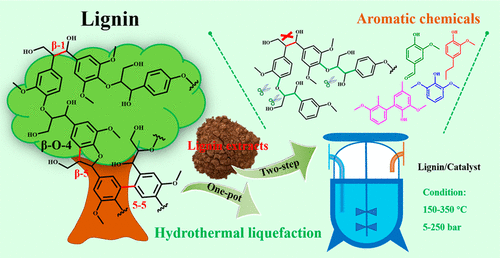当前位置:
X-MOL 学术
›
Ind. Eng. Chem. Res.
›
论文详情
Our official English website, www.x-mol.net, welcomes your feedback! (Note: you will need to create a separate account there.)
Hydrothermal Liquefaction of Lignin to Aromatic Chemicals: Impact of Lignin Structure
Industrial & Engineering Chemistry Research ( IF 3.8 ) Pub Date : 2020-05-28 , DOI: 10.1021/acs.iecr.0c01617 Yang Cao 1, 2 , Cheng Zhang 3 , Daniel C.W. Tsang 4 , Jiajun Fan 5 , James H. Clark 1, 2, 5 , Shicheng Zhang 1, 2, 6
Industrial & Engineering Chemistry Research ( IF 3.8 ) Pub Date : 2020-05-28 , DOI: 10.1021/acs.iecr.0c01617 Yang Cao 1, 2 , Cheng Zhang 3 , Daniel C.W. Tsang 4 , Jiajun Fan 5 , James H. Clark 1, 2, 5 , Shicheng Zhang 1, 2, 6
Affiliation

|
There has been a growing interest in advanced technology that transforms biomass-derived feedstock into renewable chemicals. Hydrothermal liquefaction (HTL) of lignin into low-molecular-weight fragments (e.g., monomer, dimer, and oligomer), and subsequent catalyzed transformations, offer the promise of unlocking diverse aromatic products. In consideration of the diversity of lignin feedstocks, we shed light on the impact of variations in lignin structure on the conversion efficiency. This review aims to present the latest advances in the HTL of lignin and highlights key factors (reaction solvent, temperature, catalysts, and in particular lignin types) in reductive/oxidative processes by evaluating the yield of aromatic monomers and the selectivity of target products. The mechanistic studies based on lignin model compounds were summarized to provide deep understanding of the reaction pathways to prove the crucial roles of lignin structures and high-performance catalysts in controlling catalytic activity. Finally, we emphasize that advances in emerging HTL technology, catalyst design, and structural analysis hold promise for lignin valorization.
中文翻译:

木质素对芳香族化合物的水热液化:木质素结构的影响
对将生物质来源的原料转化为可再生化学品的先进技术的兴趣与日俱增。木质素的水热液化(HTL)成低分子量片段(例如,单体,二聚体和低聚物),以及随后的催化转化,提供了释放各种芳族产物的希望。考虑到木质素原料的多样性,我们阐明了木质素结构变化对转化效率的影响。这篇综述旨在介绍木质素HTL的最新进展,并通过评估芳香族单体的收率和目标产物的选择性,重点介绍还原/氧化过程中的关键因素(反应溶剂,温度,催化剂,尤其是木质素类型)。总结了基于木质素模型化合物的机理研究,以提供对反应途径的深入理解,以证明木质素结构和高性能催化剂在控制催化活性中的关键作用。最后,我们强调,新兴的HTL技术,催化剂设计和结构分析方面的进展为木质素的增值提供了希望。
更新日期:2020-05-28
中文翻译:

木质素对芳香族化合物的水热液化:木质素结构的影响
对将生物质来源的原料转化为可再生化学品的先进技术的兴趣与日俱增。木质素的水热液化(HTL)成低分子量片段(例如,单体,二聚体和低聚物),以及随后的催化转化,提供了释放各种芳族产物的希望。考虑到木质素原料的多样性,我们阐明了木质素结构变化对转化效率的影响。这篇综述旨在介绍木质素HTL的最新进展,并通过评估芳香族单体的收率和目标产物的选择性,重点介绍还原/氧化过程中的关键因素(反应溶剂,温度,催化剂,尤其是木质素类型)。总结了基于木质素模型化合物的机理研究,以提供对反应途径的深入理解,以证明木质素结构和高性能催化剂在控制催化活性中的关键作用。最后,我们强调,新兴的HTL技术,催化剂设计和结构分析方面的进展为木质素的增值提供了希望。






































 京公网安备 11010802027423号
京公网安备 11010802027423号